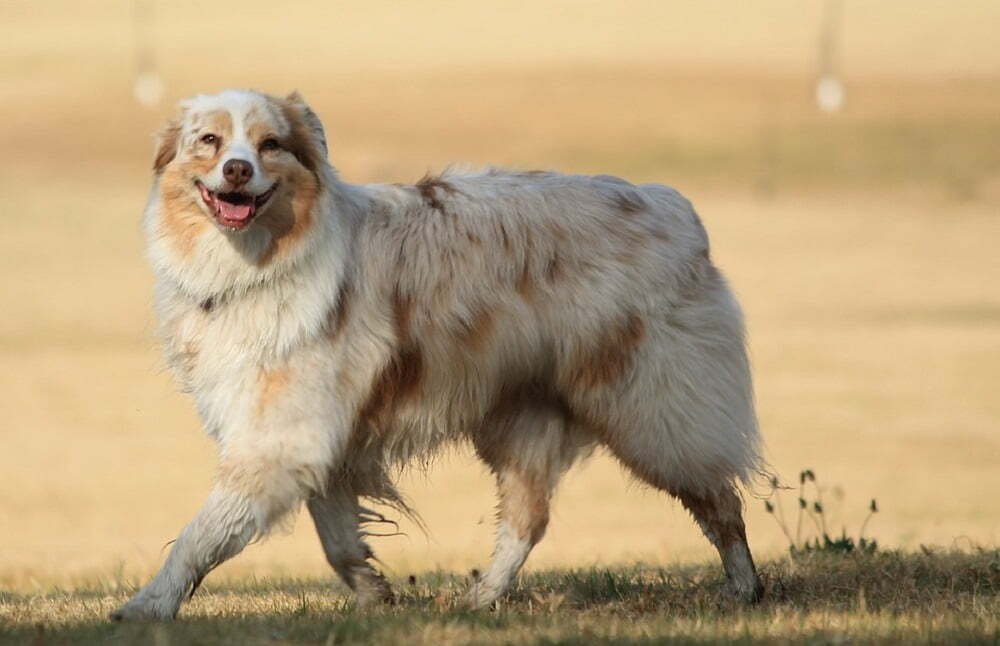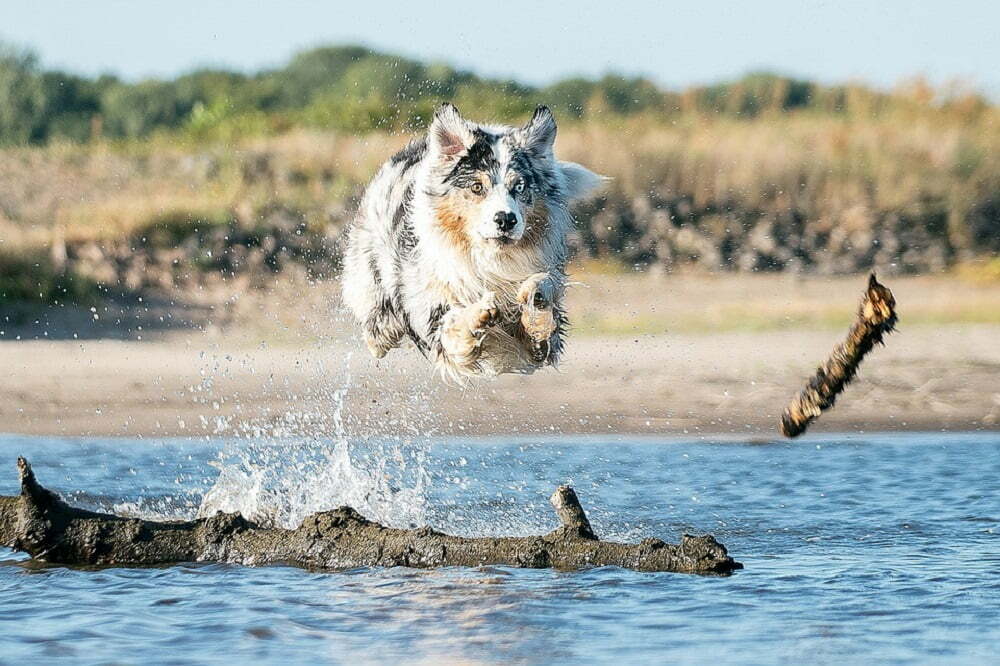If you’re looking to get a dog, you’ll first have to decide what type of dog you want and if you have any specific breed in mind. After all, a dog’s breed can determine a big part of its appearance, temperament, and daily needs.
Australian Shepherds are a type of herding dog, and they have recently become incredibly popular as pets and family companions due to their amazing nature, trainability, and temperament. But before you make the jump, you need to know all the basics about this type of dog to ensure it’s the right fit.

In this guide, we can tell you everything you need to know, from all the key facts to appearance and temperament, to health, trainability, history, and more.
Are you ready? Then let’s get into it!
Key facts about an Australian Shepherd:
Australian Shepherds, also popularly referred to as Aussies, are very high-energy dogs that are well suited to an active and outdoorsy lifestyle. They are incredibly intelligent and easy to train and are also known to be very loving and loyal.
Oh, and despite the name being “Australian” Shepherd, they aren’t actually from Australia! But we’ll talk about that later on when we cover the history of the breed.
To get you started, here are some of the most important key facts about Australian Shepherds:
- Average lifespan: between 13 and 15 years
- Size: medium
- Coat length: medium
- Minimum exercise per day: two hours
- Minimum cost per month: around $90 on average
The appearance of an Australian Shepherd:
Australian Shepherds are medium-sized dogs with an athletic build designed to be highly active. Their average height is between 18 and 23 inches tall, and they usually weigh between 40 and 60 pounds. As a general rule, males will be slightly taller and heavier than their female counterparts.
In regards to their coat, it is medium-length and soft and can be either straight or slightly wavy. They also have feathering on the back of their legs and a good amount of fur around the neck. So basically, they’re fluffy soft dogs.
As for the colors can vary between blue or red merle or red or black tricolor paired with white or tan markings.
They also tend to have naturally short tails compared to the standard tail length of a dog of a similar size.
And as we already mentioned, they have an athletic build, with a small head and floppy ears.
The temperament of an Australian Shepherd:
Every dog has its unique personality, full of quirks and traits, and many of these can reflect the owners or their upbringing. However, temperament is slightly different.
Each dog breed will have a different overarching temperament, which defines the main personality traits they are prone to. And usually, this temperament has been developed in a way that reflects the original working purpose of the dog throughout history.
It’s important to know the temperament of a breed of dog before committing. If possible, you should also enquire about the temperament of the parents of your potential dog, as some traits can be hereditary!
Australian Shepherds are working dogs, originally bred as herding dogs to work with livestock and cattle. This means that they aren’t just active; they are also confident and able to take on a dominant role.
Australian Shepherds know how to take the lead, and they can even become quite pushy if not trained right, as they will instinctively want to herd people and other animals. So if you’re a first-time owner, you will need to do a lot of training from early on so that your Aussie knows that you’re in charge and that you call the shots!
Australian Shepherds are also very loyal to their owners and family and have a very strong sense of pack. They are incredibly loving and affectionate with their own, and completely safe and gentle around children and other pets.
However, they will often be standoffish and distant when it comes to strangers and unfamiliar people, and they could also get somewhat protective.
One of the most important things about the Australian Shepherd’s temperament is that it has a lot of great qualities. Still, they need to be honed for companionship and dulled down from their original working purpose.
So a lot of socialization and training is needed from the early stages so that your Aussie gets out of that instinctive “work” mindset and instead is a loving and friendly companion.
Australian Shepherds are also one of the most intelligent breeds of dogs, meaning they are very good at interacting with humans and at perceiving what is wanted from them. On the flip side, they need a lot of mental stimulation to avoid boredom. Mainly because they might turn to destructive behavior, trying to get the owner’s attention if they get bored.
Health and Grooming of an Australian Shepherd:

Different breeds of dogs have different grooming needs, mainly depending on their coat type. But also, they will have different health risks and different health tendencies, which you need to be aware of beforehand in order to provide the best possible care.
Grooming:
In regards to grooming, Australian Shepherds have a medium-sized coat that is fluffy and soft. And one of the most important things you need to know about this coat is that it sheds all year round.
And during spring, when it gets to the shedding season, they shed even more. So basically, be prepared to deal with a lot of dog hair all over your home, because it’s inevitable. (It also means it’s not the best dog breed for those that are allergic!)
You should brush your Australian Shepherd’s coat around once a week, but daily when it gets to shedding season so that you can get rid of the bulk of hair faster and with less of a hassle. Because the hair is medium in length, you can sometimes use a do hair conditioner (ideally diluted with water) before you brush the coat to help detangle and keep it smooth.
And when brushing, you should do so in the direction the hair grows, making sure you get all the way down to the skin, as the undercoat also sheds and can also get tangled.
If regularly brushed, your Australian Shepherd won’t really need regular bathing. Instead, you should only give them a bath when properly dirty (like when they’ve been rolling around in the mud), and you should use special shampoo for dogs to ensure it is safe and won’t dry out their skin.
Another grooming needs are just nail trimming, which you should do regularly to prevent splintering. Basically, if you can hear the nails clicking on the floor, they need trimming. But if your Aussie spends a lot of time outdoors, the nails might keep themselves naturally trimmed.
Health:
In regards to health, Australian Shepherds are generally very healthy, and they shouldn’t require that many journeys to the vet. Chances are, your Aussie will be fit and healthy and will never get any of the diseases or health problems common in the breed.
Nevertheless, it’s important to be aware of the main diseases and health problems that affect Australian Shepherds so you know what to look out for when something seems wrong. It’s also worth saying that you should always check the health record and history of the parents, as a lot of health problems are hereditary! So if you’re buying your Aussie from a breeder, ask for those records.
Here are the main health issues that affect Australian Shepherd dogs:
- Hip Dysplasia:
This condition is common in most medium to large dogs and is mostly heritable. It is a condition that occurs when the femur doesn’t properly fit into the pelvic socket of the hip joint.
The main symptoms are lameness on the rear legs, pain when walking or moving, and later on, arthritis and other more serious complications. According to the Orthopedic Foundation for Animals, dogs that suffer from hip dysplasia shouldn’t be bred (as they would pass it on to the puppies). This is why it is very important to ask the breeder for proof that the parents have been tested and cleared.
- Elbow Dysplasia:
This is similar to hip dysplasia, but the condition is located in the dog’s elbow. It is caused by different growth rates between the different bones of the area, and by rapid bone growth. Plus, it is also heritable.
The main symptoms are lameness and pain; the suggested treatments are pain medications or surgery.
- Epilepsy:
This is a disorder that can cause seizures, and that can never be cured. However, many treatments and medications help deal with it, allowing the dog to live a normal life.
- Deafness:
Deafness is one of the biggest health risks in Australian Shepherds. It can be either partial deafness, progressive hearing loss, or complete deafness. It can be quite hard to train and take care of a deaf dog, and it will require a lot more time and effort. However, in some cases, there are medications and surgeries to help improve the condition, even though it cannot be cured.
- Progressive Retinal Atrophy (PRA):
This is a degenerative eye disorder in which your dog slowly loses the ability to see until it eventually causes blindness. It can be detected before it begins to happen, but there is no cure.
However, a blind dog can still live a happy life; it will just take a little more time and effort to provide the appropriate care.
- Cataracts:
This is something that will usually happen in old age, so you shouldn’t have to worry about it before then. It causes difficulty with sight, and it will give your dog’s eyes a cloudy appearance. Sometimes it can be cured through surgery.
- Distichiasis:
This condition occurs when an additional row of eyelashes (referred to as distichia) grows on the oil gland of your dog’s eye, protruding into the edge of the eyelid. This causes irritation of the eyes, and you will notice that your Aussie is constantly squinting or rubbing the eye.
This can be treated surgically, and then the problem is solved.
- Allergies:
This is common in almost all dogs and can be allergies to different foods or seasons. (Very much like humans!) Some medications can help, and the best way to deal is to avoid the allergy triggers as much as possible.
- Drug sensitivity:
This is common in herding breeds such as the Australian Shepherd. It means that they might not be able to take certain medications, but the vet can test this beforehand.
- Cancer:
Just like humans, dogs can develop cancers of different types. Sometimes, if caught in time, they can be treated successfully.
The trainability of an Australian Shepherd:
Australian Shepherds are working dogs with a high level of intelligence, which means that they are very easy to train, and they are eager to do well and please. If trained properly, an Australian Shepherd can do almost anything, as they pick up on new commands and activities quickly.
One of the most important parts of training your Australian Shepherd is socialization. Herding dogs can be very dominant and pushy, and they might get protective and defensive with strangers and try to herd children or other pets.
Regular socialization will teach your Aussie to be friendly and open to everyone and help reduce the herding instinct so that they aren’t as pushy. This can include regular meet-ups with other dogs and people, taking them to dog centers and dog activities, and more.
Australian Shepherds are also very popularly trained for athletic competitions and obstacle courses, as they are seriously one of the best breeds for it, and will often have it very easy to win or, at the very least, place within the top. Speed, agility, and obedience. You could even add in dancing and similar, your Australian Shepherd can do it all if trained from early on!
History of the Australian Shepherd:

As we mentioned early in the article, Australian Shepherds aren’t actually from Australia. Pretty deceiving, right? They were developed in the United States during the 19th century, and the name comes from the sheep and cattle imported from Australia, and that the Australian Shepherd was known for herding.
It became incredibly popular because it was one of the best herding dogs. And nowadays, it remains just as popular or even more, thanks to being a great family pet and companion. It is especially suited to outdoor lifestyles and those that love adventuring and being active, and of course, they are still used for herding nowadays in rural places!
Costs of having an Australian Shepherd:
Owning a dog doesn’t come free. There are a few different important expenses that you need to be aware of, as they are necessary in order to provide the right care. On average, you can expect to pay around $90 or so per month to keep your Australian Shepherd happy and thriving. Of course, this can massively depend on where you live and the lifestyle you lead with your dog.
Here is the main Australian Shepherd costs to consider:
- Purchase cost:
If you’re going to buy your Australian Shepherd puppy from a reliable and official breeder, it’s not going to come cheap. It can cost you anywhere from $300 to $3000, depending on whether it’s pedigree or not.
Alternatively, you could just adopt an Australian Shepherd from a dog adoption center or shelter, in which case you will only pay for the adoption fees, and these are usually very cheap.
- Initial costs:
When you first get an Australian Shepherd, especially if it’s a puppy, there are a few necessary initial costs to set up right from the start.
The main ones to consider are:
- Vaccines
- A microchip
- Neutering (This is highly recommended unless you want to breed your dog in the future and have more puppies)
- Dog equipment (Such as a dog bed, a dog collar, leash, bowls, and more. Some you will have to replace over time regularly)
- Ongoing costs:
The ongoing costs are the bulk of the monthly cost of keeping an Australian Shepherd, and they are the things that you need to buy to take care of your dog constantly.
Such as dog food, pet insurance or vet bills, poo bags, dog treats, dog toys, and other things.
- Other costs:
Other costs include professional dog trainers, dog day-care, emergency vet bills, and similar.
Fun Facts about Australian Shepherds:
Here are some extra fun facts about Australian Shepherds:
- They often have two different colored eyes
- Some are born with shorter tails
- They are used not only for herding but also for search and rescue, and many other jobs, thanks to their high intelligence and trainability
